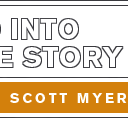Thanks for this take, Laura. Sorkin's points of narrative focus -- The Trial, The Riots, the "sibling" relationship between Tom Hayden and Abbie Hoffman -- is certainly reflected in the script and movie.
With regard to the first two (Trial, Riots), as you point out, there is a clear line of demarcation: The Chicago 7 (plus Bobby Seale) are Protagonist figures aligned against The Powers That Be, including Judge Hoffman, who are the Nemesis figures. But there's a *lot* of "mask" switching at work.
Note: Think of "masks" like ancient Greek plays where actors would hold up various masks in front of their face to indicate a switch in the character they were performing. So, too, in movies and TV whereby any character at any point may "don" one of five primary character archetypes "masks": Protagonist, Nemesis, Attractor, Mentor, Trickster.
For instance, there is a sequence (137-152) in which Hayden, who wants to get on the witness stand and testify, relives the experience of how, when witnessing his friend Rennie Davis being assaulted by Chicago police, he (Hayden) impulsively grabs the mic at the rally and urges the crowd to head to the convention center, let "blood flow in the streets."
At that moment, he dons a Trickster mask because he has in effect turned into an enemy of the cause, directly contradicting his *own* previously held position they should *not* attempt to move toward the convention center.
If you go through the script, there are a bunch of scenes where characters suddenly switch, e.g., David Dellinger in the courtroom striking a cop, Schultz requesting a mistrial for Bobby Seale.
But the heart and soul of the story is the third storyline which Laura has detailed: the relationship between Tom and Abbie. And it *is* like a big brother / little brother relationship. But here, too, we see some mask-switching going on. The default mode is Tom as Mentor and Abbie as Trickster, and from scene to scene, each donning a nemesis mask because of their mutual animosity toward each other. They represent two widely divergent philosophical perspectives: Tom to somehow work The System to a progressive agenda; Abbie to upend The System. Over time, they come to understand and respect each other. This is capped off in Act Three with the previously noted sequence in which it is shown that Tom cannot possibly get on the witness stand due to his inflammatory speech which led to violence in Chicago and Abbie's testimony at the trial. It turns out that Abbie *does* respect Tom, that Abbie *is* actually thoughtful about politics, not just a yippie, and that his take on political matters mirrors in his own way what Tom Hayden is about.
That "buddy story" between the two carries much of the emotional weight of the story.
